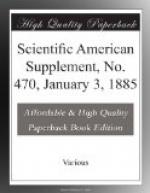The experiments of Despretz and Regnault had shown that the scope of Mariotte’s law (that the volume of gases increases or diminishes inversely as the pressure upon them) was limited, and that its limits were different with different substances. Andrews confirmed the observations of these investigators, and extended them. Compressing carbonic acid at 13 deg. C. (55 deg. Fahr.), he found that the rate of diminution in volume increased more rapidly than Mariotte’s law demanded, and at a progressive rate. At fifty atmospheres the gas all at once assumed the liquid form, became very dense, and fell to the bottom of the vessel, where it remained separated from its vapor by a clearly defined surface, like that which distinguishes water in the air. Experimenting in the same way with the gas at a higher temperature (21 deg. C. or 70 deg. Fahr.), he found that the same result was produced, but more slowly; and it seemed to be heralded in advance by a more rapid diminution in volume previous to the beginning of the change, which continued after the process had been accomplished; as if an anticipatory preparation for the liquid state were going on previous to the completion of the change. Performing the experiment again at 32 deg. C. (90 deg. Fahr.), the anticipatory preparation and the after-continuation of the contraction were more marked, and, instead of a separate and distinct liquid, wavy and mobile striae were perceived on the sides of the vessel as the only signs of a change of state which had not yet been effected. At temperatures above 32 deg. C. (90 deg. Fahr.), there were neither striae nor liquefaction, but there seemed to be a suggestion of them, for, under a particular degree of pressure, the density of the gas was augmented, and its volume diminished at an increasing rate. The temperature of 32 deg. C. (90 deg. Fahr.) is, then, a limit, marking a division between the temperatures which permit and those which prevent liquefaction; it is the critical point, at which is defined the separation, for carbonic acid, between two very distinct states of matter. Below this point, the particular matter may assume the aspect of a liquid; above it, the gas cannot change its appearance, but enters into the opposite constitution from that of a liquid.
Generally, a liquid has considerably greater density than its vapor. But, if a vessel containing both is heated, the liquid experiences a dilatation which is gradually augmented till it equals and even exceeds that of the gas; whence, of course, an equal volume of the liquid will weigh less and less. On the other hand, a constantly larger quantity of vapor is formed, which accumulates above the liquid and becomes heavier and heavier. Now if the density of the vapor increases, and that of the liquid diminishes, they will reach a point, under a suitable temperature, when they will be the same. There will then be no reason for the liquid to sink or the vapor to rise, or for the existence of any line of separation between




